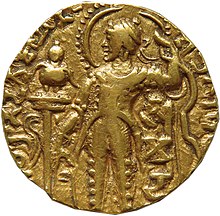Samudra Gupta
| Samudragupta | |
|---|---|
| Mahārājādhirāja | |

Coin of Samudragupta, with Garuda pillar, emblem of Gupta Empire.
|
|
| 4th Gupta Emperor | |
| Reign | c. 336 – c. 380 CE |
| Predecessor | Chandragupta I |
| Successor | Chandragupta II or Ramagupta |
| Spouse | Dattadevi |
| Issue | Chandragupta II, Ramagupta |
| House | Gupta dynasty |
| Father | Chandragupta I |
| Mother | Kumaradevi |
Samudragupta (r. c. 335 – c. 380 CE) was the fourth ruler of the Gupta Empire and the son and successor of Chandragupta I. His rule was one of expansion marked first by the conquest of his immediate neighbours and then by campaigns to the east and the south where chiefdoms and kingdoms were subdued and forced to pay tribute to him. Much of the knowledge of Samudragupta's military exploits comes from the Allahabad Pillar of Ashoka which includes a prashasti (a eulogy) extolling the deeds and virtues of the Gupta emperor. Going by the inscription, Samudragupta exerted direct or indirect control over much of the Indian subcontinent stretching from kingdoms in Nepal and the Punjab in the north all the way to the Pallava kingdom at Kanchipuram in the south-east.
Samudragupta was the son of Chandragupta I and the Lichchhavi princess, Kumaradevi. He is believed to have been his father's chosen successor even though he had several elder brothers. Therefore, some believe that after the death of Chandragupta I, there was a struggle for succession in which Samudragupta prevailed. It is said that Samudragupta became the ruler after subduing his rival, Kacha, an obscure prince of the dynasty.
Samudragupta is depicted on his coins both as a muscular warrior flaunting the "marks of hundreds of wounds received in battle" as well as a poet and a musician. His reign marked the beginning of what is popularly referred to as the golden age of Indian history, a period where the arts and architecture flourished under the patronage of the Guptas. While his son, Chandragupta II, is generally considered Samudragupta's successor, according to the Devi-chandra-gupta, a play wrought a couple of centuries later, Ramagupta acceded to the throne first before being overthrown by his brother, Chandragupta II.
Chandragupta I, a Magadha king, was the third ruler of the Gupta Dynasty and married a Lichhavi princess, Kumaradevi. This enabled him to gain a hold over the Ganges river-basin, the main source of North Indian commerce. He ruled from his capital at Pataliputra for about ten years in north-central India with his son, Samudragupta, as an apprentice.
...
Wikipedia
